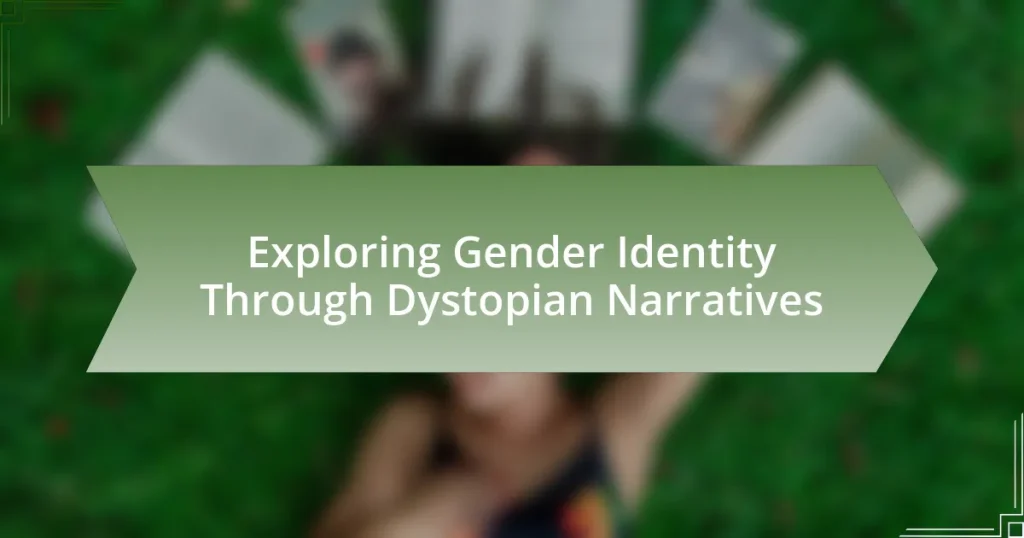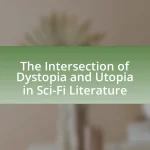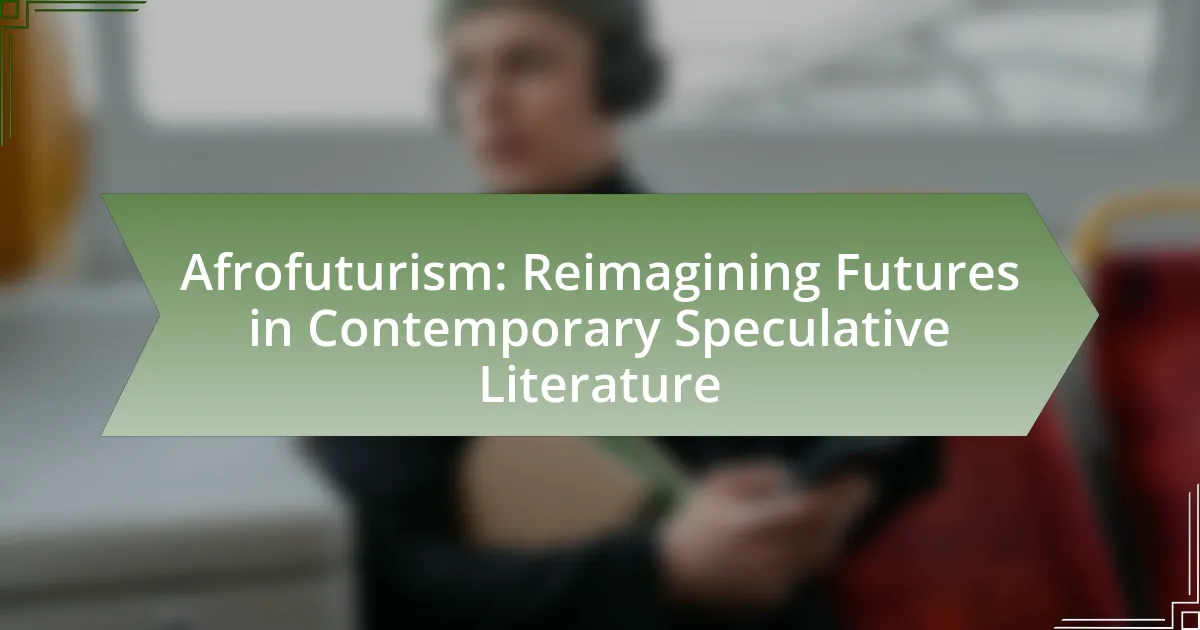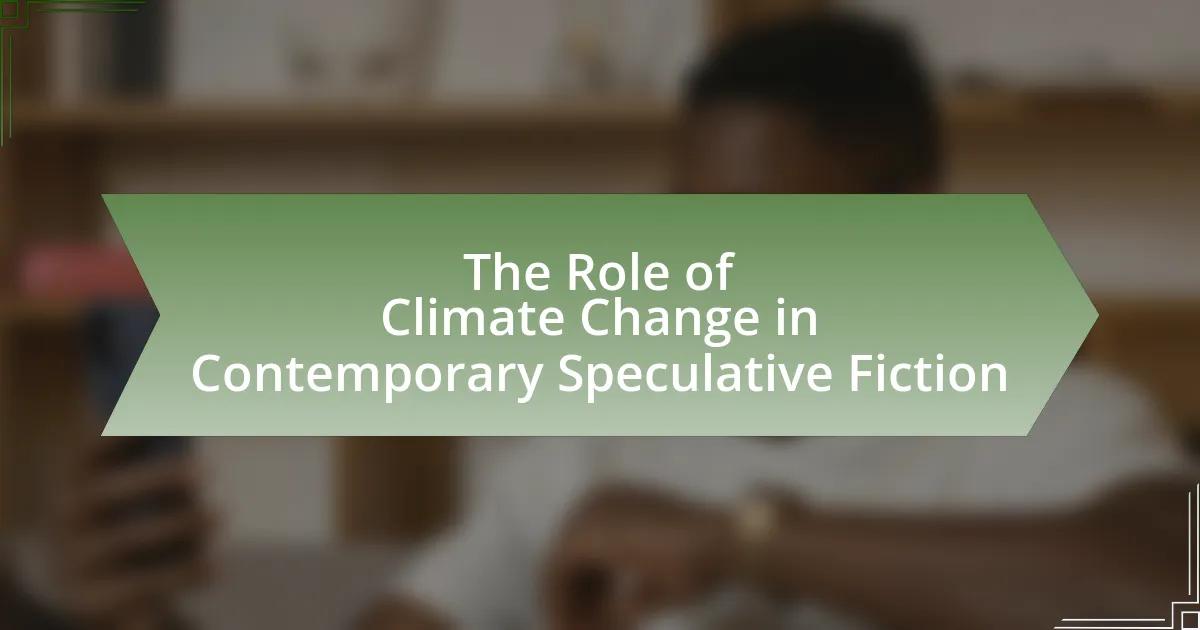The article “Exploring Gender Identity Through Dystopian Narratives” examines how gender identity is represented and explored within oppressive societal structures in dystopian literature. It highlights the struggles characters face against rigid gender norms imposed by authoritarian regimes, using examples from notable works such as “The Handmaid’s Tale” by Margaret Atwood and “Brave New World” by Aldous Huxley. Key themes include the fluidity of gender, societal expectations, and the impact of oppression on individual identity. The article also discusses how dystopian settings challenge traditional gender norms and influence societal views on gender identity, ultimately prompting critical reflection on contemporary gender issues.
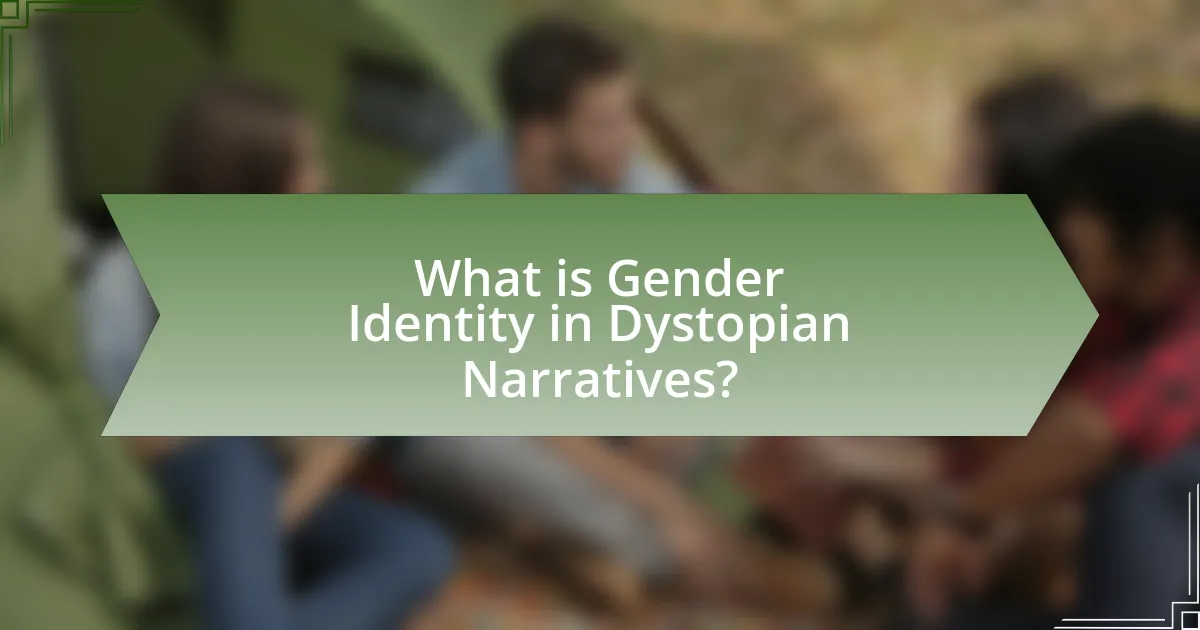
What is Gender Identity in Dystopian Narratives?
Gender identity in dystopian narratives refers to the representation and exploration of individual gender identities within oppressive societal structures. These narratives often highlight the struggles and conflicts faced by characters as they navigate rigid gender norms imposed by authoritarian regimes. For instance, in works like “The Handmaid’s Tale” by Margaret Atwood, gender identity is central to the plot, illustrating how a totalitarian society enforces strict roles based on gender, thereby stripping individuals of their autonomy and identity. This thematic focus serves to critique real-world gender inequalities and provoke discussions about identity, power, and resistance in the face of systemic oppression.
How is gender identity portrayed in dystopian literature?
Gender identity in dystopian literature is often portrayed as a construct manipulated by oppressive regimes to control individuals. In works like “The Handmaid’s Tale” by Margaret Atwood, gender roles are strictly defined, with women relegated to reproductive functions, illustrating how totalitarian societies can distort and restrict personal identity. Similarly, in “Brave New World” by Aldous Huxley, the commodification of human relationships and the suppression of individuality highlight the impact of societal norms on gender identity. These narratives serve as critiques of real-world gender inequalities, emphasizing the consequences of rigid gender roles and the struggle for self-definition in oppressive environments.
What themes related to gender identity are commonly explored?
Commonly explored themes related to gender identity include the fluidity of gender, societal norms and expectations, the impact of oppression, and the quest for self-identity. These themes are often depicted in dystopian narratives, where characters navigate rigid societal structures that challenge their understanding of gender. For instance, works like “The Handmaid’s Tale” by Margaret Atwood illustrate the consequences of enforced gender roles, while “Gender Trouble” by Judith Butler discusses the performative aspects of gender, emphasizing its non-binary nature. Such narratives provide critical commentary on how societal constructs shape individual identities and experiences.
How do dystopian settings influence perceptions of gender identity?
Dystopian settings significantly influence perceptions of gender identity by creating environments that challenge traditional gender roles and norms. In these narratives, societal structures often enforce rigid classifications of gender, which can lead to heightened awareness and critique of gender identity issues. For example, in Margaret Atwood’s “The Handmaid’s Tale,” the totalitarian regime’s strict control over women’s bodies and roles highlights the consequences of patriarchal oppression, prompting readers to reflect on contemporary gender dynamics. Additionally, dystopian literature frequently explores themes of resistance and fluidity in gender identity, as seen in works like “Parable of the Sower” by Octavia Butler, where characters navigate and redefine their identities in response to societal collapse. This exploration fosters a deeper understanding of gender as a social construct, encouraging discussions about identity beyond binary classifications.
Why is gender identity significant in dystopian narratives?
Gender identity is significant in dystopian narratives because it often serves as a lens through which societal norms and power structures are critiqued and deconstructed. In many dystopian settings, rigid gender roles are imposed to control individuals, reflecting real-world issues of gender inequality and oppression. For example, in Margaret Atwood’s “The Handmaid’s Tale,” the subjugation of women is central to the regime’s control, highlighting the dangers of extreme patriarchal systems. This narrative not only illustrates the consequences of gender-based oppression but also prompts readers to question contemporary gender dynamics and the implications of identity in authoritarian contexts.
What role does gender identity play in character development?
Gender identity significantly influences character development by shaping motivations, conflicts, and relationships within narratives. Characters often navigate societal expectations and personal truths related to their gender identity, which can drive their actions and decisions. For instance, in dystopian narratives, characters may challenge oppressive systems that enforce rigid gender norms, leading to transformative arcs that highlight resilience and self-discovery. This dynamic is evident in works like “The Handmaid’s Tale” by Margaret Atwood, where the protagonist’s struggle against a patriarchal regime underscores the impact of gender identity on personal agency and societal roles. Such narratives illustrate how gender identity not only informs individual character journeys but also critiques broader societal structures.
How does gender identity affect societal structures in these narratives?
Gender identity significantly influences societal structures in dystopian narratives by shaping power dynamics, social roles, and individual agency. In these narratives, characters often navigate oppressive systems that enforce rigid gender norms, which can lead to marginalization or empowerment based on their identity. For instance, in “The Handmaid’s Tale” by Margaret Atwood, the totalitarian regime subjugates women, illustrating how gender identity can dictate one’s societal position and rights. This reflects real-world implications, as studies show that societies with strict gender roles often experience higher levels of inequality and violence, reinforcing the narrative’s critique of such structures.

How do Dystopian Narratives Challenge Traditional Gender Norms?
Dystopian narratives challenge traditional gender norms by depicting societies where gender roles are subverted or redefined, often highlighting the fluidity of gender identity. For instance, in works like “The Handmaid’s Tale” by Margaret Atwood, women are stripped of their autonomy, yet they also exhibit resistance and agency, which critiques patriarchal structures. Similarly, in “Parable of the Sower” by Octavia Butler, characters navigate a world where survival transcends gender expectations, showcasing diverse identities and roles. These narratives illustrate that gender is not a fixed binary but a social construct that can be reshaped in response to societal conditions, thereby questioning and destabilizing established norms.
What are some examples of dystopian works that subvert gender norms?
Examples of dystopian works that subvert gender norms include “The Handmaid’s Tale” by Margaret Atwood, which critiques patriarchal control over women’s bodies and reproductive rights, and “Parable of the Sower” by Octavia Butler, where a female protagonist navigates a chaotic society while challenging traditional gender roles. Additionally, “The Power” by Naomi Alderman explores a world where women develop the ability to produce electric shocks, reversing gender dynamics and power structures. These works illustrate how dystopian narratives can challenge and redefine societal expectations regarding gender.
How do characters in these narratives defy conventional gender roles?
Characters in these narratives defy conventional gender roles by exhibiting traits and behaviors traditionally associated with the opposite gender. For instance, female characters often take on leadership roles, displaying strength and assertiveness, while male characters may show vulnerability and emotional depth. In “The Handmaid’s Tale” by Margaret Atwood, Offred challenges patriarchal norms by asserting her identity and agency despite oppressive circumstances. Similarly, in “The Power” by Naomi Alderman, women gain physical power, subverting traditional gender dynamics. These examples illustrate how characters actively resist societal expectations, thereby redefining gender roles within their dystopian contexts.
What impact do these subversions have on readers’ understanding of gender?
Subversions in dystopian narratives significantly enhance readers’ understanding of gender by challenging traditional gender roles and norms. These narratives often depict characters who defy societal expectations, thereby prompting readers to question the rigidity of gender binaries. For instance, works like “The Handmaid’s Tale” by Margaret Atwood illustrate the consequences of extreme gender oppression, encouraging readers to reflect on contemporary gender issues. Additionally, the portrayal of fluid gender identities in dystopian settings fosters empathy and awareness, allowing readers to explore diverse experiences beyond conventional frameworks. This engagement with subverted gender roles ultimately leads to a more nuanced comprehension of gender as a social construct rather than a fixed identity.
Why do authors choose to challenge gender norms in dystopian settings?
Authors choose to challenge gender norms in dystopian settings to critique societal structures and explore the implications of gender inequality. By placing characters in oppressive environments, these authors highlight the absurdity and consequences of rigid gender roles, often reflecting real-world issues such as patriarchy and systemic discrimination. For instance, in Margaret Atwood’s “The Handmaid’s Tale,” the totalitarian regime’s control over women’s bodies serves as a stark commentary on contemporary debates surrounding women’s rights and autonomy. This approach not only engages readers in critical discussions about gender but also encourages them to envision alternative realities where gender norms can be redefined or dismantled.
What messages about gender identity are conveyed through these challenges?
The challenges in dystopian narratives convey messages about the fluidity and complexity of gender identity. These narratives often depict characters who defy traditional gender norms, illustrating that gender is not binary but exists on a spectrum. For example, in works like “The Handmaid’s Tale” by Margaret Atwood, the oppressive regime enforces rigid gender roles, highlighting the consequences of societal attempts to control identity. This serves as a critique of real-world gender discrimination and emphasizes the importance of self-identification and autonomy in understanding one’s gender. Such portrayals encourage readers to question societal norms and recognize the diverse experiences of gender identity.
How do these narratives reflect real-world gender issues?
Dystopian narratives reflect real-world gender issues by illustrating the consequences of societal norms and power dynamics that marginalize certain gender identities. For instance, in many dystopian stories, characters face oppression based on their gender, mirroring real-life challenges such as gender-based violence, discrimination, and the struggle for equality. These narratives often depict extreme scenarios where traditional gender roles are enforced or subverted, highlighting the fragility of gender identity in oppressive systems. Research shows that literature can serve as a lens to examine and critique societal structures, as seen in works like “The Handmaid’s Tale” by Margaret Atwood, which critiques patriarchal control and reproductive rights, resonating with contemporary discussions on women’s autonomy and rights.
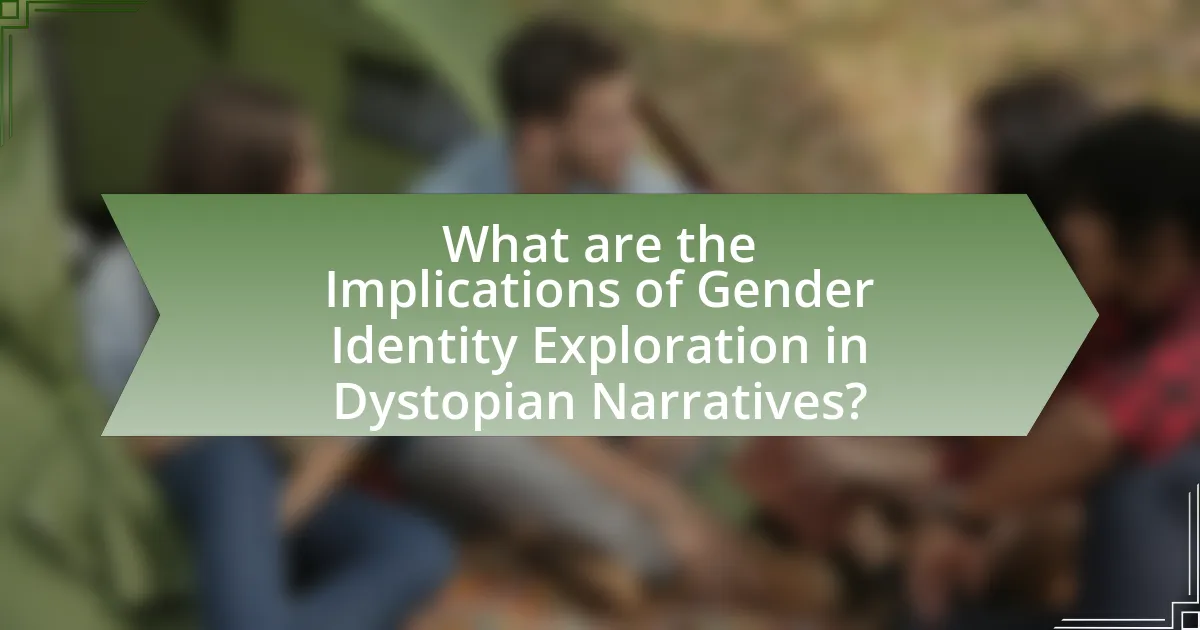
What are the Implications of Gender Identity Exploration in Dystopian Narratives?
The implications of gender identity exploration in dystopian narratives include the challenge to societal norms and the examination of identity fluidity. Dystopian settings often amplify the consequences of rigid gender roles, allowing characters to navigate and redefine their identities in ways that critique real-world gender binaries. For instance, in works like “The Handmaid’s Tale” by Margaret Atwood, the oppressive regime enforces strict gender roles, highlighting the dangers of a society that limits individual identity. This exploration can lead to greater awareness and discourse on gender diversity, as seen in contemporary narratives that reflect ongoing societal debates about gender identity and expression. Such narratives serve as a mirror to current issues, prompting readers to reconsider their own perceptions of gender and identity.
How do dystopian narratives influence societal views on gender identity?
Dystopian narratives significantly influence societal views on gender identity by presenting extreme scenarios that challenge traditional norms and provoke critical reflection. These narratives often depict societies where gender roles are rigidly enforced or entirely subverted, prompting audiences to question the validity and implications of their own gender constructs. For instance, in works like “The Handmaid’s Tale” by Margaret Atwood, the portrayal of a theocratic regime that reduces women to reproductive vessels critiques patriarchal control and highlights the consequences of gender oppression. Such depictions can lead to increased awareness and discourse surrounding gender identity, as they encourage individuals to consider the fluidity of gender and the societal structures that shape it. Research indicates that exposure to diverse gender representations in media, including dystopian fiction, correlates with greater acceptance and understanding of non-binary and transgender identities, thereby reinforcing the narrative’s impact on societal perceptions.
What lessons can be learned from the portrayal of gender identity in these stories?
The portrayal of gender identity in these stories teaches the importance of understanding and accepting diverse identities. These narratives often highlight the struggles faced by individuals who do not conform to traditional gender norms, illustrating the societal pressures and discrimination they encounter. For instance, in dystopian settings, characters may experience extreme consequences for their gender expression, reflecting real-world issues such as systemic oppression and the fight for rights. This representation emphasizes the need for empathy and advocacy for marginalized groups, showcasing that acceptance can lead to a more inclusive society.
How can these narratives inspire change in contemporary discussions about gender?
Dystopian narratives can inspire change in contemporary discussions about gender by highlighting the consequences of rigid gender norms and the importance of gender fluidity. These stories often depict societies where traditional gender roles lead to oppression, prompting readers to reflect on the implications of such structures in real life. For instance, works like “The Handmaid’s Tale” by Margaret Atwood illustrate the dangers of a society that enforces strict gender roles, encouraging discussions about autonomy and equality. Additionally, narratives that feature diverse gender identities challenge binary perceptions and promote acceptance, as seen in “Parable of the Sower” by Octavia Butler, which presents a protagonist who embodies resilience and adaptability in a chaotic world. Such representations can foster empathy and understanding, ultimately driving societal change towards more inclusive gender discussions.
What practical insights can be gained from exploring gender identity in dystopian narratives?
Exploring gender identity in dystopian narratives reveals practical insights into societal norms and the consequences of rigid gender roles. These narratives often depict extreme scenarios where traditional gender identities are challenged or subverted, highlighting the fluidity of gender and the impact of oppressive systems on individual identity. For instance, in Margaret Atwood’s “The Handmaid’s Tale,” the enforced roles of women serve as a critique of patriarchal control, illustrating how societal structures can dictate personal identity and autonomy. This exploration encourages critical reflection on contemporary gender issues, emphasizing the importance of inclusivity and the dangers of authoritarianism in shaping identity.
How can readers apply these insights to understand gender identity in their own lives?
Readers can apply insights from dystopian narratives to understand gender identity in their own lives by recognizing the complexities and fluidity of gender as depicted in these stories. Dystopian literature often challenges traditional gender norms and highlights the struggles individuals face in expressing their identities, which can resonate with readers’ personal experiences. For instance, novels like “The Handmaid’s Tale” by Margaret Atwood illustrate the consequences of rigid gender roles, prompting readers to reflect on their own societal contexts and the impact of gender expectations. This reflection can lead to a deeper understanding of their identities and the importance of advocating for inclusivity and acceptance in their communities.
What strategies can be used to engage with dystopian narratives critically regarding gender identity?
Engaging critically with dystopian narratives regarding gender identity can be achieved through several strategies. One effective strategy is to analyze the representation of gender roles within the narrative, examining how these roles are constructed and challenged. For instance, in Margaret Atwood’s “The Handmaid’s Tale,” the rigid gender roles serve as a critique of patriarchal structures, prompting readers to reflect on contemporary gender dynamics.
Another strategy involves comparing the dystopian elements with real-world gender issues, such as systemic oppression or identity politics, to highlight parallels and provoke critical thought. Research by scholars like Susan Sontag emphasizes the importance of understanding the socio-political context of narratives, which can deepen the analysis of gender identity within dystopian settings.
Additionally, employing intersectional analysis allows for a more nuanced understanding of how various identities intersect within the narrative, revealing complexities often overlooked in traditional gender studies. This approach is supported by Kimberlé Crenshaw’s work on intersectionality, which underscores the importance of considering multiple identities in social critique.
Lastly, engaging in discussions or forums that focus on these narratives can foster diverse perspectives, enriching the critical engagement process. This collaborative approach aligns with the findings of the “Journal of Gender Studies,” which highlights the value of community discourse in understanding gender identity in literature.
